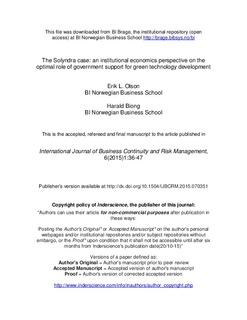| dc.contributor.author | Olson, Erik L. | |
| dc.contributor.author | Biong, Harald | |
| dc.date.accessioned | 2016-01-20T13:15:40Z | |
| dc.date.available | 2016-01-20T13:15:40Z | |
| dc.date.issued | 2015 | |
| dc.identifier.citation | International Journal of Business Continuity and Risk Management, 6(2015)1: 36-47 | nb_NO |
| dc.identifier.issn | 1758-2164 | |
| dc.identifier.issn | 1758-2172 | |
| dc.identifier.uri | http://hdl.handle.net/11250/2374349 | |
| dc.description | This is the authors' accepted and refereed manuscript to the article | nb_NO |
| dc.description.abstract | More than three years after its highly publicized bankruptcy, Solyndra continues to resonate as an example of well-intentioned government policies gone wrong. This paper examines the Solyndra case using an institutional economics perspective to determine if the government’s relationship with the firm was optimal in achieving environmental and energy public policy goals while minimizing risk. The analysis reveals several government deviations from theory prescribed best practice, and illustrates opposing theoretical governance prescriptions for stimulating future technological innovation at the macro and micro levels. | nb_NO |
| dc.language.iso | eng | nb_NO |
| dc.publisher | Inderscience | nb_NO |
| dc.title | The Solyndra case: an institutional economics perspective on the optimal role of government support for green technology development | nb_NO |
| dc.type | Journal article | nb_NO |
| dc.type | Peer reviewed | nb_NO |
| dc.source.journal | International Journal of Business Continuity and Risk Management | nb_NO |
| dc.identifier.doi | 10.1504/IJBCRM.2015.070351 | |
| dc.description.localcode | 1, Forfatterversjon | nb_NO |
